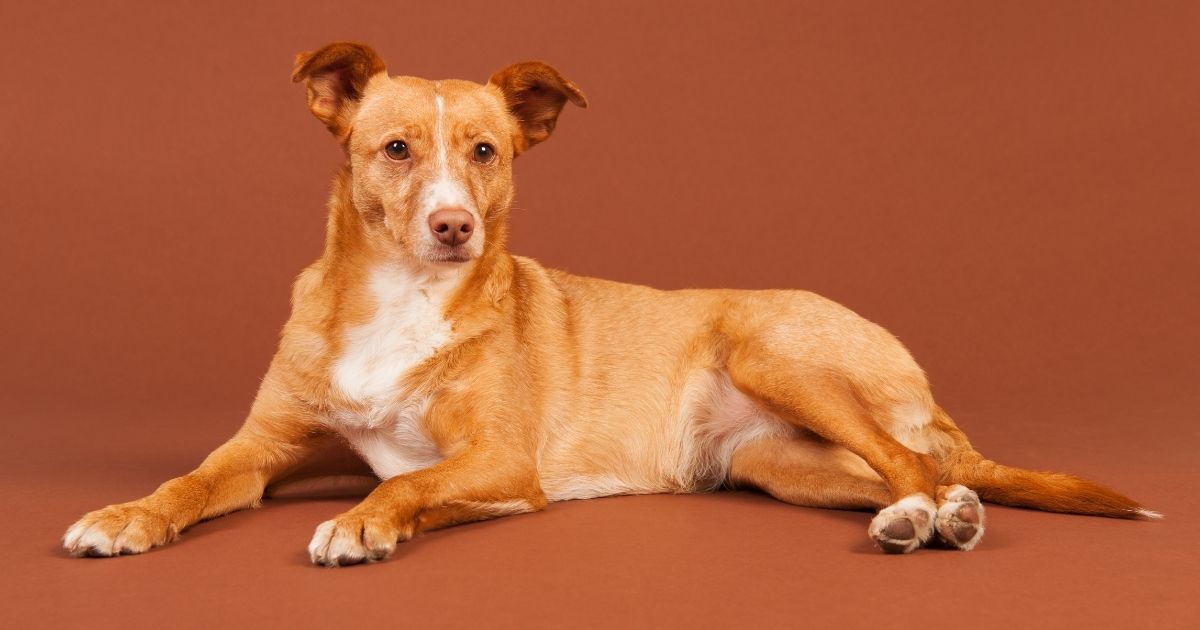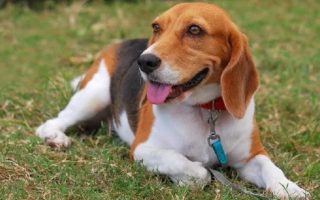Originating from the Spanish region of Andalusia, the Andalusian Hound dog breed is a ‘jack of all trades’ in Houndville.
He fits into the subcategories of a scenthound, a sighthound, and some more—little wonder he was developed to hunt a variety of prey.
With his endearing traits and high intelligence, the Andalusian Hound has been able to worm his way into some American households, despite being rare in other countries outside Spain.
There is an appeal that comes with owning an uncommon breed, and that draws people to the Andalusian Hound.
The following sections present Andalusian Hound dog breed information, facts, characteristics, behavior, temperament, training, grooming needs, and more, to help you decide if this breed is right for you.
Key Andalusian Hound Facts and Information
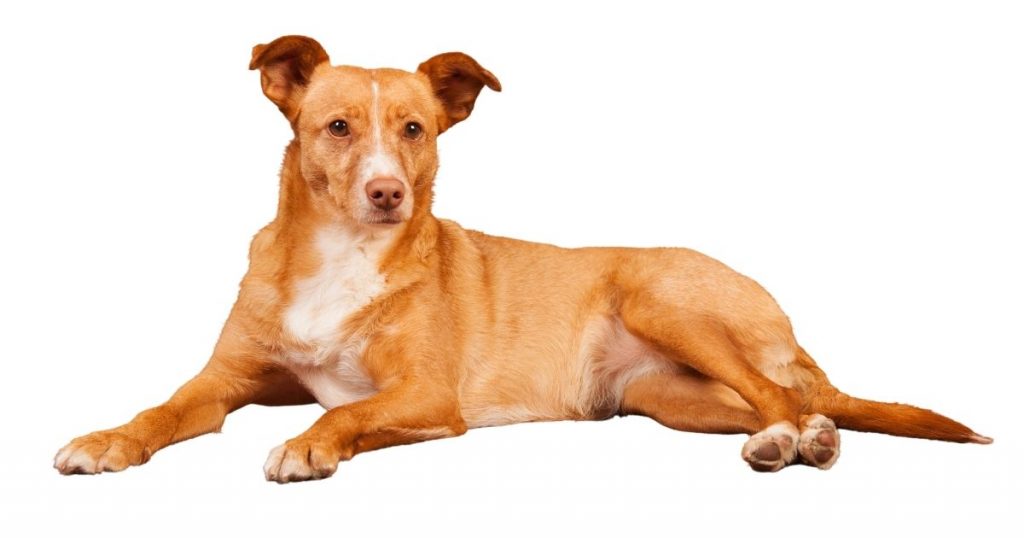
| Dog Breed Group | Hound Group |
| Height | 13 to 25 inches |
| Weight | 11 to 73 pounds |
| Coat | Wiry, Long, Smooth |
| Color(s) | White, Cinnamon |
| Life Expectancy | 10 – 12 years |
| Temperament / Behavior | Intelligent, Energetic, Cheerful |
| Origin | Spain |
| Bred For | Hunting |
| Nickname(s) / Other Name(s) | Andalusian Podenco, Podenco Andaluz, Podenco Andalusian, Podenco Maneto Andalusian |
Andalusian Hound Characteristics
| Adaptability | They adapt to different environments |
| Friendliness | Some are friendly, others don’t bond easily |
| Kid-Friendly | A bit friendly with children |
| Pet-Friendly | Can cope with other pets when socialized well |
| General Health | They are healthy and not prone to serious conditions, but falls ill sometimes |
| Grooming Needs | Moderate grooming |
| Trainability | Trainable |
| Intelligence | A very intelligent |
| Playfulness | A playful breed |
| Exercise Needs | Needs daily exercise |
| Energy Level | Higher energy level than many other breeds |
| Tendency to Bark | An average barker |
| Tendency to Drool | High |
| Tendency to Snore | Low |
| Tendency to Dig | High |
Interesting facts about Andalusian Hound Dog Breed
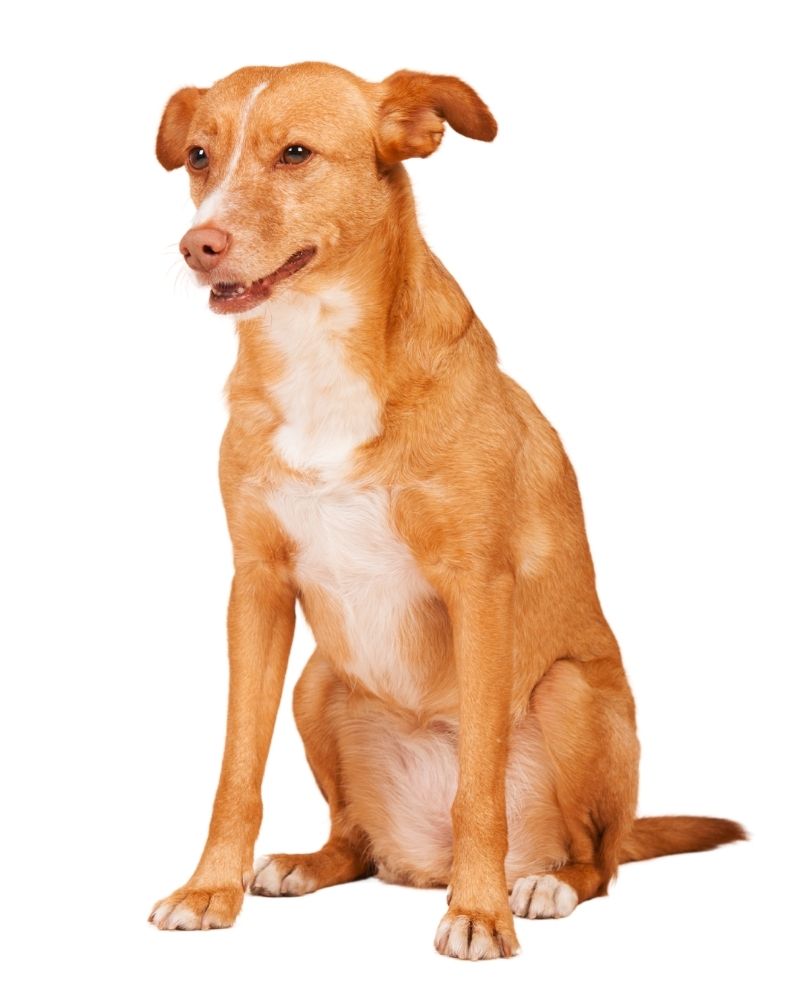
Fact #1. The Andalusian Hound comes in three sizes
Rather than one definite size, the Andalusian Hound has three different sizes: the small, medium, and large.
The small Andalusian has a height of 13 to 17 inches with a weight of 11 to 24 pounds.
The medium-sized Andalusian is 17 to 21 inches tall and weighs 22 to 49 pounds.
The large Andalusian grows as tall as 21 to 24 inches and weighs 46 to 73 pounds.
Fact #2. They have strong senses
The Andalusian Hound was bred to be a hunter, and they did a good job at that. Successful breeding made them very skilled.
Unlike other hunting dogs who rely on a particular sense organ, the Andalusian Hound uses all three major ones.
They have a keen sense of smell, sight, and sound.
Fact #3. They originated from Spain
As the name implies, the Andalusian Hound originated from Spain, in the Andalusian region.
Fact #4. They are not recognised outside Spain
Unfortunately, the Andalusian Hound is not well known outside Spain and has no formal recognition. None of the Kennel Clubs registered this breed.
Fact #5. They are similar to some other dog breeds
The Andalusian Hound shares similarities with dog breeds from the Mediterranean region like the Ibizan Hound, the Maneto, the Portuguese Podengo, and the Podenco Canario.
History & Origin
The Andalusian Hound is a Spanish breed developed for the purpose of hunting game. Their ancestors are most likely the European Hunting Dog.
While it seems that the Andalusian Hound is an old breed, no one can say how old. There were some dogs found in ancient cave paintings in the Iberian peninsula.
Some speculate that the Andalusian Hound was part of those dogs, but the theory is uncertain.
What we do know is that the Andalusian Hound remained unrecognized till the 1990s.
Thanks to the work of Phillipe Bloque-Rentòn and colleagues, a breed group was established.
The Real Sociedad Canina de España recognised the breed in 1992. In January 2015, the Andalusian Hound got recognized in Germany.
The American Kennel Club, United Kennel Club, and the Fédération Cynologique Internationale haven’t recognized this breed.
The reason is the Andalusian Hound is too similar to the Portuguese Podengo, giving the former no distinctive feature.
Andalusian Hound Temperament, Behavior & Intelligence
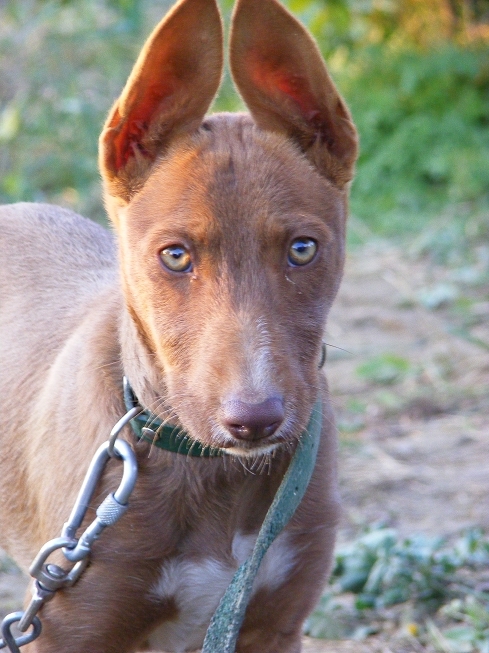
Loyalty is one of the Andalusian Hound’s biggest traits. No doubt, they picked it up from their hunting days.
They are also predisposed to be gentle, a quality that makes them fit to be pet.
They stay alert and observe their environment using all senses. They are wary of strangers and would bark to alert you of any new face.
These qualities combined make them good guard dogs and watchdogs.
This cheerful, playful dog got the energy to spare. He needs some activity and playtime to be at his best.
Another top quality of the Andalusian Hound is their high intelligence. Their ability to pick up on commands and act on them makes them trainable.
They are also submissive and inclined to please their owners. They thrive when under the authority of a gentle, confident pet parent.
Is an Andalusian Hound a good family dog?
Though not known, the Andalusian Hound adds value to the families that own them. Their cheerfulness can break through a cloud of despair.
Their keen alertness, stamina, and barking tendencies make them good guard dogs and watchdogs. They are easy to train as well.
They may be hard to find outside the Spanish region, but the search for this breed is worthwhile.
Are Andalusian Hounds good with kids?
While not much is known about how the large Andalusian Hound fares with kids, the medium and small variations are good with kids and pose no significant threat.
Socialization is necessary, though, especially when the kids are grown. The Andalusian Hound needs to know your kids belong to the family.
Also, inculcate good manners in your kids so they would know how to treat a dog with respect and care.
Are Andalusian Hounds good with other dogs and pets?
While the Andalusian Hound can flow with other dogs, it takes some time to get them used to have other canines in their turf. Here, you need to socialize them with care.
They may also do well with cats, though it’s a hit-or-miss. They are not suitable for a house with other smaller pets because of their high prey drive.
Male vs Female Andalusian Hound
The Andalusian Hound gender differences do not matter if one wants to decide which makes a better pet.
Like many other dog breeds, both come with a set of pros and cons and both make good household companions.
In all three versions of the Andalusian Hound, the male is taller than the female by about an inch. They weigh similar pounds. To the average onlooker, the male and female Andalusian Hounds are indistinguishable.
With no record stating otherwise, it is safe to say they share similar personalities.
Many other factors like environment, role, and even the family they stay with can influence their behaviors and temperaments. However, there may be no gender predispositions.
Like other dogs, Andalusian Hounds require a male-female mating to reproduce. Thus, their sexual organs differ.
The female has reproductive quality but requires a male to conceive. Spaying and neutering your pet will take away this ability if you’re not keen on puppy litters.
Overall, both the male and female Andalusian Hound make good companions and hunters.
Caring for an Andalusian Hound
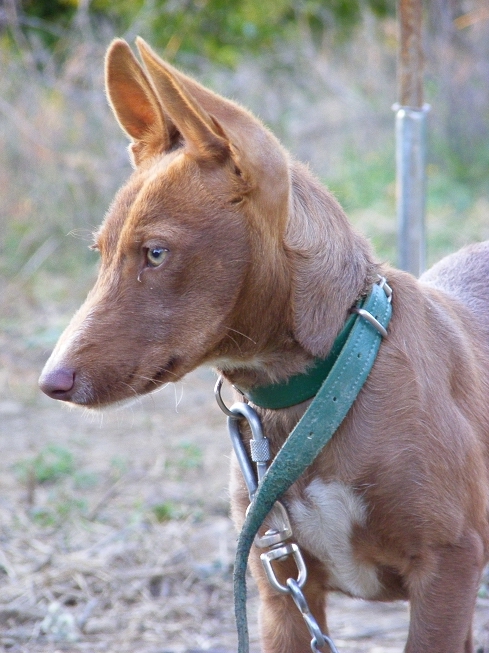
The first thing to consider when taking care of an Andalusian Hound is the type you have.
The needs of a small Andalusian Hound differ from that of a large Andalusian Hound. However, they all need exercise, irrespective of their size.
They also need to eat, and the diet should fit their size. Don’t forget to train them, groom them on a regular basis and maintain their health.
Food and Diet
The individual Andalusian Hound needs a diet suitable for his size.
Because they come in different sizes, it is tough to have a guideline that encompasses all their feeding requirements.
We offer some suggestions but consult a veterinarian for further information.
All variations of the Andalusian Hound need enough protein to thrive. Protein also spans across all ages.
Puppies need protein to grow, adults need protein to stay healthy while seniors need protein to curb deterioration.
The small and medium Andalusian Hound needs quality dry food and the large ones should have a diet designed for the big boys.
If you feed this dog breed without exercising them sufficiently, they risk getting obese. There should be a balance between feeding and exercise.
A good way to control feeding is to use a schedule. This prevents free feeding and trains your dog to expect food only at a particular time.
Exercise
This high-energy hunting breed is not meant to lie around all day, doing nothing.
Not only would that put them at risk of gaining weight, but they may also develop some undesirable habits.
If you want your Andalusian Hound to remain calm throughout the day, give him enough exercise.
The evergreen dog walk has proven to be beneficial for many breeds, including the Andalusian Hound. It is a good time to have fun, socialize with your pet, and stay fit.
Running is another great activity the Andalusian Hound loves. As a hunter with stamina, running is a part of him.
This makes him a good partner for early morning jogs and sprints. If you’re not a runner, consider taking your Andalusian to a dog park or keep him in a fenced yard with sufficient space.
A puppy shouldn’t be allowed to run, though. Their bones are fragile and may be broken if overworked. With the Andalusian puppy, it is best to start small.
A few minutes’ walks and playtime with toys are good activities for him.
Beyond physical activities, the intelligent Andalusian Hound should be mentally stimulated.
Mental activities are you shooting two birds with one stone as it is a form of training. Some ways to mentally stimulate your Andalusian Hound includes:
- A game of puzzle
- Teaching tricks
- Exploring
- Smelling games
Do not assume your Andalusian senior doesn’t need exercise because he moves around less.
While he shouldn’t be overworked, exercise helps him stay balanced and healthy in those last days.
The Andalusian Hound requires a variety of training methods to be mannered. Undesirable habits shouldn’t be entertained.
This is why you should start training your Andalusian as a puppy. At that age, he’s a blank canvas, ready for your teachings.
The best time to start is when your puppy is between 8 to 12 weeks.
New pet parents can attempt training an Andalusian Hound, but they won’t find it easy.
While the Andalusian Hound is intelligent and submissive, they were bred to be hunters.
They are used to independent thinking and may want to do things their own way. Someone who doesn’t understand this would get frustrated.
You must be patient and gentle with the Andalusian Hound. Harsh treatments and punishments would make your Andalusian Hound lose trust and respect for you.
To make training more effective, don’t make it a long session. That would tire both you and your pet.
Instead, break it down into short, consistent sessions. A 5 minutes session, 3 to 5 times daily is recommended.
Use praises and rewards to keep your pet happy, interested, and cooperative.
Support them when need is and rebuke them with gentleness when they do something wrong.
Rather than pat your Andalusian on the head, pat them beneath the chin or on the chest instead. It communicates more love.
Owners tend to be blind to puppies’ cuteness and frailty. They indulge these pups and ‘spoil’ them.
When you do this, it becomes harder to change those behaviors when they grow. A better way is to set rules and boundaries immediately.
Grooming Needs
A clean dog reflects well on the owner, and the Andalusian Hound is not an exception.
They have a moderate grooming need, which means you should put more effort into taking care of their coat and hygiene.
It is a task you can do yourself to save costs. If you have neither the time nor the interest, then hire a groomer.
The grooming needs of an Andalusian Hound includes:
Coat Care
The best tool you need to tend to the Andalusian Hound’s coat is a medium tooth comb. With it, go through the coat.
Use a slicker brush too to untangle the fur and mats. A second brushing is recommended after some minutes, then you can choose to apply a conditioner.
You can clip their hair if you think it’s necessary.
Ears Cleaning
The Andalusian Hound has long ears. It is most likely the first thing you’d notice on them. Those ears need proper cleansing.
Dogs with long ears are vulnerable to ear infections, so you should beware of that. Use a cotton ball and an ear cleanser only.
Paws / Nails Trimming
With the aid of a nail clipper, take care of the Andalusian Hound’s paws by trimming their nails. The Andalusian Hound runs a lot, and long nails may injure him.
If you’re not good with this, hire someone who can. It won’t bode well if you injure your pet.
Bathing
Bathing cleans off the dirt from your Andalusian Hound and wards off a bad odor. This dog breed doesn’t get easily dirty, so bathing should not be done often.
Use only shampoo to bathe your dog. Any other substance might cause an allergic reaction.
Teeth Brushing
Dental hygiene is the next grooming need you should cover. This should be regular and done with care. Use a toothbrush and canine toothpaste to do the job.
Good dental care reduces the chances of toothache and tooth decay.
Eyes Cleaning
This is a delicate aspect of grooming, and you shouldn’t try it yourself if you are inexperienced.
Eye cleaning involves removing eye gunk using an ‘eye comb’. Do not use your hands.
Health Conditions
You have a major role to play in maintaining an Andalusian Hound’s health, and one way to do that is through every other aspect of canine care.
Vaccination and regular checkups also ensure good health.
The Andalusian Hound boast of good health and a relatively long life span, and not much is recorded on their health status.
However, there are some illnesses that are known to affect Andalusian Hounds. They include:
Ear infections
As earlier mentioned, Andalusian Hounds are prone to ear infections because of their long ears.
Ear infections are common and not considered serious—though they make your dog uncomfortable and bring an extra bill.
Common symptoms include whining, scratching of ears, or head shaking.
Arthritis
Arthritis is more common with older dogs, a senior Andalusian Hound inclusive. It occurs when the joints get swollen.
The cartilage in the joints of an affected dog is damaged, making the bones rub together.
The friction is painful and stiffens the joint as new bones grow around the joint. Arthritis is uncomfortable and suffers your dog.
Eye Conditions
There are many forms of eye conditions a dog can suffer. Glaucoma, cherry eye, cataract, and conjunctivitis are popular examples.
The symptoms include swelling, eye redness, sensitivity to light, and continuous blinking.
FAQs
What are Andalusian Hounds known for?
Andalusians were bred to be excellent hunters with stamina and a keen sense of smell, sight, and sound. They are known for tracking down games for their hunting masters.
Is an Andalusian Hound right for you?
They are cheerful, loyal, and playful. They are also intelligent and submissive, traits that make them trainable. With their strong sense organs and alertness, they make good watchdogs and guard dogs.
The Andalusian Hound is a special, rare breed that makes pet parenting a delight.
Taking into account their downsides like drooling and other behavioral problems, the Andalusian Hound is right for you if you can handle their challenges and harness their strengths.
How big is a full-grown Andalusian Hound?
The Andalusian Hound comes in three sizes: small, medium, and large. Their height ranges from 13 to 25 inches and their weight, 11 to 73 pounds.
Do Andalusian Hound like to cuddle?
Andalusian Hounds can cope indoors, but they’re meant for the outdoors. This is not the best pet choice if you want a dog to cuddle.
Is it hard to take care of an Andalusian Hound?
Caring for the Andalusian Hound involves meeting their needs. They have a moderate grooming need, are trainable, and need normal consistent exercise. Effort is required, but it isn’t hard to take care of an Andalusian Hound.
How Long do Andalusian Hounds live?
Andalusian Hounds have a fairly long life span and are healthy dogs. They live as long as 12 years.
How Much are Andalusian Hounds?
Because they are not known outside Spain, Andalusian Hounds are hard to find. This makes them a bit costly. The average cost for a puppy is $650.
Do Andalusian Hounds shed?
Andalusian Hounds are low shedders and only let out hair as a natural process. This is good if you don’t fancy dog fur all over.
What does Andalusian Hound prey on?
Andalusian Hounds were bred to be hunters and have a high prey drive. The small and medium Andalusian Hound preyed on rabbits, while the large ones hunted boars.
Final Thoughts
Getting an Andalusian Hound as a hunting buddy is a top choice. Having one as a companion is even better.
His versatility out in the fields and in the home makes him a formidable predator, worker, and friend.
While they are not suitable for everyone, the Andalusian Hound is a good addition to any household that can accommodate his excesses and satisfy his needs.
Related:

